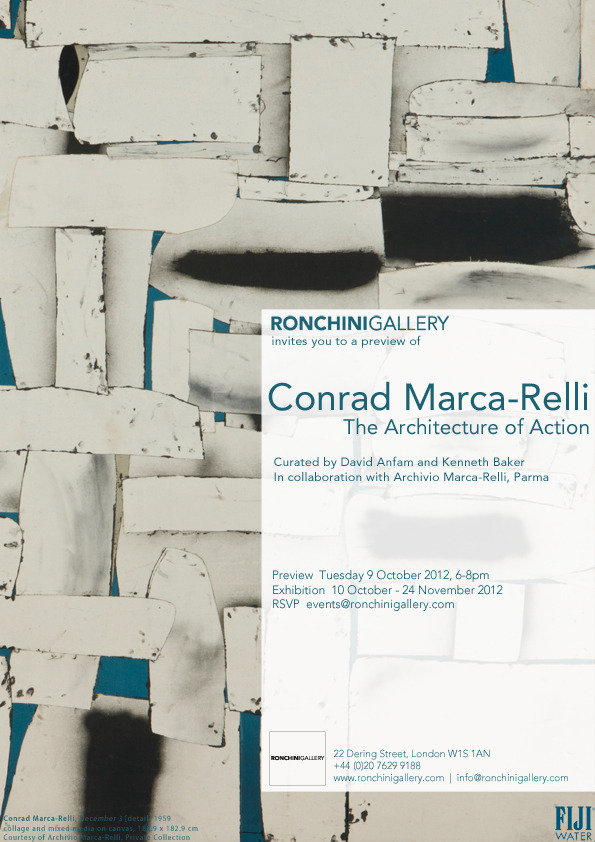Conrad Marca-Relli
dal 8/10/2012 al 23/11/2012
Segnalato da
8/10/2012
Conrad Marca-Relli
Ronchini Gallery, London
The Architecture of Action. The retrospective will feature a selection of works spanning the pioneering American Abstract Expressionist's, allowing the viewer to chart the evolution of this artist.

curated by Kenneth Baker and David Anfam
Ronchini Gallery London, in collaboration with Archivio
Marca-Relli, Parma, will present Conrad Marca-Relli:
The Architecture of Action, the artist’s first UK solo
exhibition. Curated by Kenneth Baker and David
Anfam, from 10 October to 24 November 2012, the
retrospective will feature a selection of works spanning
the pioneering American Abstract Expressionist’s
impressive 60 year career.
Born in Boston, Massachusetts, moving permanently
to New York City in 1926, Marca-Relli (1913–2000) was
a central figure of the New York School of Abstract
Expressionism that emerged after the Second World
War, alongside Jackson Pollock, Willem de Kooning,
Philip Guston and Franz Kline. His name nearly
synonymous with collage, Marca-Relli completely
redefined the art form famously pioneered by Cubist
masters Pablo Picasso and Georges Braque. Collage
fascinated Marca-Relli, whose works were often
monumental in scale, and combined oil paint and
other media.
This exhibition, some 45 years after his first retrospective at the Whitney Museum of
American Art in 1967, brings together a selection of works spanning his expansive career,
allowing the viewer to chart the evolution of this remarkable artist. Marca-Relli’s works
explore various media, with materials ranging from vinyl plastics and cut-out aluminium to
various fabrics and patterns provided by newsprint. Over the years these works developed
an abstract simplicity, evidenced by black or sombre colours and rectangular shapes
isolated on neutral backgrounds. Sometimes entire series consisted only of muted earth
tones, while others included splashes of colour, or explorations of various palettes.
A seminal work, Death of Jackson Pollock (1956), is a collage and mixed media on canvas
spanning over one metre by two metres, completed soon after the death of Marca-Relli’s
close friend and neighbour, Jackson Pollock. Marca-Relli and his wife had grown close to
Pollock after moving to Springs in the Hamptons, where Pollock tragically lost control of his
car while driving drunk on the night of 11 August 1956. Shortly after he finished the epic
tribute to his friend, Marca-Relli left for a stint in Europe and never again returned to live in
Springs. Not wanting to take advantage of his friendship, he refused to display the piece to
the public until 2000, shortly before his death.
Describing the night Pollock died, Marca-
Relli wrote:
“We walked a short distance and then I could see the form of a body
stretched out on the side of the road. It was Jackson. He was flat on his back,
his eyes open. There was no blood, no scars, in fact he looked so beautiful. I
just stared. I must have stayed that way for quite a while and then I heard the
officer’s voice. “Do you know this man?” “Yes,” I said listlessly, “yes, it’s
Jackson Pollock.”
With work in major exhibitions at Peggy Guggenheim Collection, Venice (1998), The
Metropolitan Museum of Art, New York (2008) and Solomon R. Guggenheim Museum, New
York (2009); Marca-Relli’s works were critical in pushing the boundaries of collage and
Abstract Expressionism, and mark him as one of America’s greats.
For press information and images please contact:
Sophie da Gama Campos or Toby Kidd at Pelham Communications
Tel: +44 (0) 208 969 3959
Email: sophie@pelhamcommunications.com or toby@pelhamcommunications.com
PV Tuesday 9 October 6-8pm
Ronchini Gallery
22 Dering Street - London



